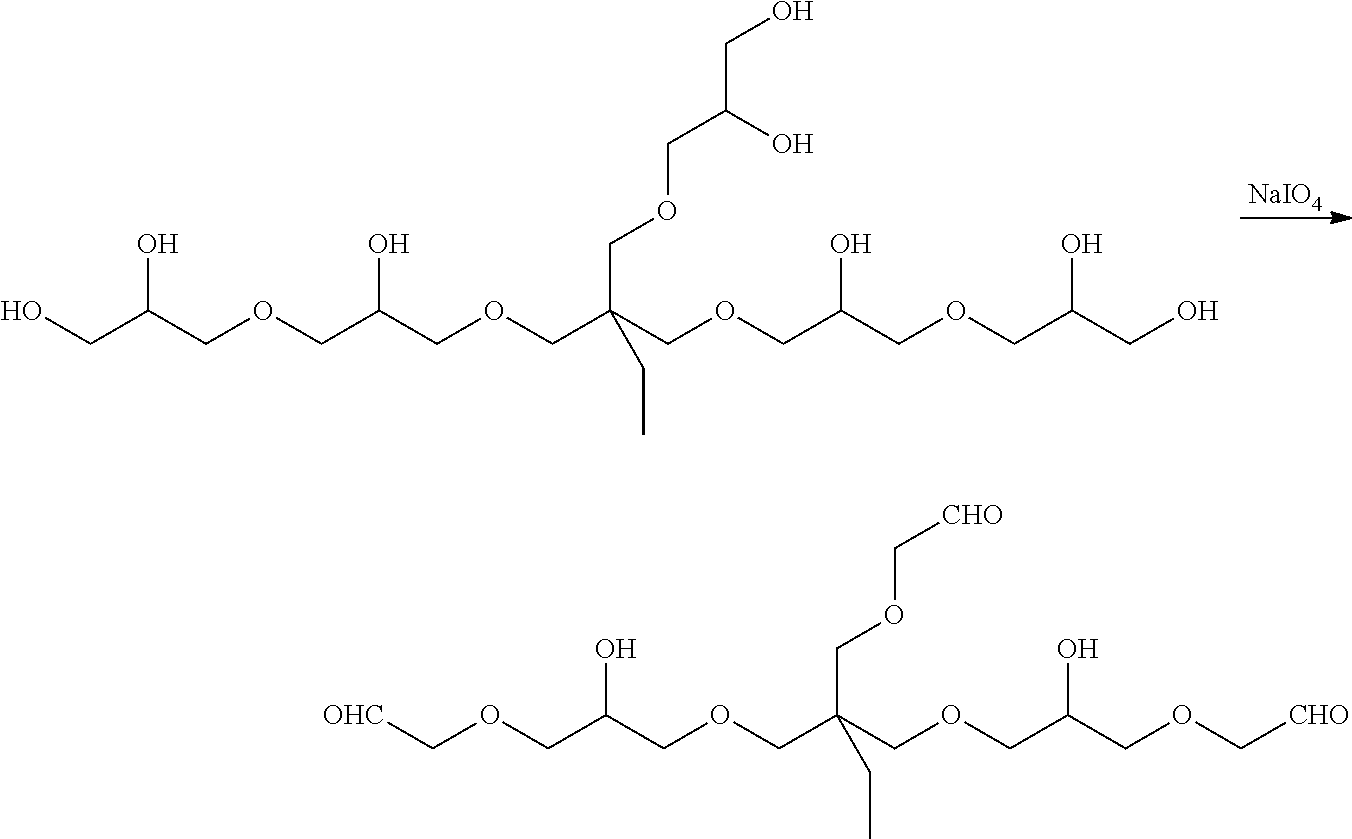Tissue adhesive and sealant comprising polyglycerol aldehyde
a tissue adhesive and polyglycerin aldehyde technology, applied in the field of medical adhesives and sealants, can solve the problems of limited internal application use of tissue adhesives, slow curing of fibrin-based adhesives, and inconvenient tissue adhesives and sealants
- Summary
- Abstract
- Description
- Claims
- Application Information
AI Technical Summary
Benefits of technology
Problems solved by technology
Method used
Image
Examples
example 1
Synthesis of Polyglycerol Aldehyde MW 500
[0111]The purpose of this Example was to prepare a polyglycerol aldehyde having an average molecular weight of about 500 Da. The polyglycerol aldehyde was prepared by oxidizing polyglycerol having an average molecular weight of about 500 Da using sodium periodate, i.e.,
[0112]A solution of 1.90 g of sodium periodate in 15 mL of water was added to a solution of 1.00 g of polyglycerol PG-500 (Hyperpolymers GmbH, Freiburg, Germany) in 15 mL of water, slowly enough to keep the reaction temperature from rising above 30° C. Once the addition was completed, the mixture was stirred at ambient temperature for 2 hours and then poured into 75 mL of methanol. After the precipitated salts had been removed by filtration, the filtrate was evaporated under reduced pressure to give the polyglycerol aldehyde product, which was characterized using 1H NMR (500 MHz, methanol-d4).
example 2
Synthesis of Polyglycerol Aldehyde MW 1,000
[0113]The purpose of this Example was to prepare a polyglycerol aldehyde having an average molecular weight of about 1,000 Da. The polyglycerol aldehyde was prepared by oxidizing polyglycerol having an average molecular weight of about 1,000 Da and a degree of branching of about 48% using sodium periodate. The degree of branching of the starting polyglycerol 1000 was determined using the 13C NMR spectroscopy method described by A. Sunder et al. (Macromolecules 32:4240-4246, 1999).
[0114]A solution of 2.52 g of sodium periodate in 20 mL of water was added to a solution of 2.09 g of polyglycerol 1000 in 10 mL of water, slowly enough to keep the reaction temperature from rising above 30° C. Once the addition was completed, the mixture was stirred at ambient temperature for 2 hours, chilled to 0° C. and filtered to remove solids. Calcium chloride dihydrate (0.67 g) was added to the filtrate, which was stirred for 30 min and then filtered to remo...
example 3
Synthesis of Polyglycerol Aldehyde MW 2,000
[0115]The purpose of this Example was to prepare a polyglycerol aldehyde having an average molecular weight of about 2,000 Da. The polyglycerol aldehyde was prepared by oxidizing polyglycerol having an average molecular weight of about 2,000 Da and a degree of branching of about 51%. using sodium periodate. The degree of branching of the starting polyglycerol 2000 was determined using the 13C NMR spectroscopy method described by A. Sunder et al. (Macromolecules 32:4240-4246, 1999) and was also calculated from its number average molecular weight (Mn) and its equivalent weight per terminal diol moiety, as described above. Both methods gave comparable results.
[0116]A solution of 21.20 g of NaIO4 in 193 mL of water was added to a solution of 21.95 g of polyglycerol 2000 (Hyperpolymers GmbH) dissolved in 86 mL of water, slowly enough to keep the reaction temperature from rising above 30° C. Once the addition was completed, the mixture was stirre...
PUM
| Property | Measurement | Unit |
|---|---|---|
| Fraction | aaaaa | aaaaa |
| Fraction | aaaaa | aaaaa |
| Fraction | aaaaa | aaaaa |
Abstract
Description
Claims
Application Information
 Login to View More
Login to View More - R&D
- Intellectual Property
- Life Sciences
- Materials
- Tech Scout
- Unparalleled Data Quality
- Higher Quality Content
- 60% Fewer Hallucinations
Browse by: Latest US Patents, China's latest patents, Technical Efficacy Thesaurus, Application Domain, Technology Topic, Popular Technical Reports.
© 2025 PatSnap. All rights reserved.Legal|Privacy policy|Modern Slavery Act Transparency Statement|Sitemap|About US| Contact US: help@patsnap.com



